SaaS is inherently user-focused. Collecting data to understand better what users need from your product helps direct how to make smarter decisions and plan for growth. If you put users first, a data-driven product strategy is the natural next step for your product-led growth (PLG) SaaS company.
Often new PLG organizations struggle during the transition with:
- Setting up an enticing free model strategy
- Implementing a fruitful monetization strategy
- Aligning the team around a new model
- Creating an effective user onboarding experience
In this article, discover the key components of an optimal data-driven product strategy, why this strategy is essential, and how to simplify the transition to PLG.
What Is a Data-Driven Product Strategy?
A product strategy is a big-picture plan for how a product will develop based on user needs. It outlines three crucial components: achieving business objectives, fulfilling customer needs, and delivering unique value.
A data-informed product strategy works harder for your organization and the users you’re serving. Put aside best guesses and use qualitative and quantitative data to make informed decisions. When you collect data from users’ behavior, responses, and other actions related to your product, hypothesizing isn’t necessary.
User data within a data-driven product strategy informs every business decision and strategy.
Organizations can leverage data while developing their strategy to grow more intentionally and make laser-focused product decisions.
Here's Why Feeding Product Data Into Your Strategy Is Critical
Data helps SaaS companies make more informed decisions.
A recent survey by Splunk found businesses that use a data-driven strategy achieve 83% more revenue to their topline and 66% more profit to their bottom line. Also, 93% of those organizations feel they make faster and better decisions than their competitors.
Of the data-driven businesses in the study, 91% agreed their organization is in a stronger position to compete and succeed in their market over the next few years.
We can expect integrated data to optimize virtually every aspect of work. Seamless interactions and smart workflows between humans and machines will most likely be commonplace.
Companies traditionally make decisions based on business-oriented data by tracking and acting upon:
- Monthly and annual revenue
- Cost of acquisition
- Number of users
- The real bottom-line
However, in a data-driven product strategy model, the user experience is the main focus. If the user is not engaging with the product, finding it easy to learn, and making the most of its features, you’re already losing them.
The user will likely churn if your product fails to solve their problem, provide a net benefit, or takes too long to learn to use.
If the data indicate that many users are experiencing the same problems, a data-driven product development team knows exactly where the pain points are and can quickly resolve them.
A study by Harvard Business Review recently found that only 5% of the surveyed retail enterprises qualified as data-driven organizations. The study also revealed that only 22% of shoppers were satisfied with the personalization they were receiving from their favorite brands.
There’s clear room for improvement and huge opportunities for any business that gets product data right.
How to Put Data-Driven Product Strategy Into Practice
Product Managers in SaaS organizations can apply a data-driven product strategy by implementing the four steps below.
1. Identify the Needs of Your Customers
Before starting data-driven product development, you must understand your user's goals and desires, what problems they need to solve, and their pain points.
Find these crucial insights about your SaaS users by looking at business records and other data sources such as:
- Support tickets and sales notes
- Information from running surveys
- Customer interviews
You want to understand what makes your users tick, what their workflows look like, and what frustrates them.
Sales teams are a goldmine of information. A good salesperson already knows a lot of the issues their customers face.
In a data-driven product strategy, the key is to carefully plan the questions you will ask. The right questions will uncover behavior and decision-making that even the customer is unaware of.
2. Improve Customer Experience and User Experience
A successful strategy comes down to user experience. In a Gartner survey, they found that in two years, 82% of B2B CMOs expect to mostly or entirely compete based on customer experience. This stat showcases that finding ways to measure and quantify user experience is vital to business growth and where a data-driven product strategy comes in.
Consumers only tolerate applications that provide a great user experience from start to finish.
Every step must flow naturally, from the onboarding experience through the initial learning curve to mastering advanced user features. Users shouldn’t feel like they are hitting barriers in their workflow, learning should complement the product, and unusual methods of operation should be removed.
Curating a seamless customer experience ultimately leads to greater user satisfaction and retention.
3. Infuse Your Insights Into the Product Development Process
Collecting insights is only helpful if you can incorporate them meaningfully into your product development process.
Here’s an example of the product development process that results in a successful product.
Google and Apple define their development guidelines when developing Android and iOS apps. In the menu, a user should expect to find support or how to go back to the previous page. This standardization makes it easy for users to adopt new apps quickly.
If you design an app with a different flow, you increase the learning curve for users and cause them unnecessary frustration.
Look at the usage data to see where users hit these barriers. Doing so allows you to make more informed decisions about improving the product and increasing user retention.
In addition to ensuring every element of your sales funnel is in the right place, machine learning is another excellent tool that dynamically engages users. The AI predicts what users will want to see next.
In a data-driven product strategy, analyzing the user’s behavioral data enables you to tap into much greater personalization of your product.
4. Emphasize Customer and End User Needs
The more a product owner understands their user’s needs, the more they can improve their experience.
You can get this data from meaningful research directly from the source: your users. This includes a granular understanding of their workflows, workday challenges, preferences, aspirations, and emotional influences.
If users can be productive and enjoy the experience, then your product will be high on their list of preferred and requested tools.
Which Data Should You Track to Make Better Product Decisions?
An unlimited number of data points could be tracked, so where is best to start?
Retention is one of the most important metrics to track. It doesn't matter how fast you onboard new customers; if you lose them at the same speed, it means you don't have a viable business.
One way to get ahead is by using data analysis to track user activity and login data. If the user is rarely logging in or is not active in the product, they have a high chance of churning.
Once you identify users that are not active, you can offer additional training material to help them benefit more from your product.
Each business case is different, but every product-led team needs quality data to make impactful decisions.
Tips for SaaS Companies That Are Just Starting to Gather Product Data
To be product-led, you want your teams rallied around specific metrics and not just driven by bottom-line revenue or metrics.
Engage teams with the key metrics that resonate across the organization. Everyone must understand what metrics are important and why, so everyone can get behind them.
To start, look at your conversion rate from a free tier or trial to a paid plan. This metric should be front and center of any product-led business.
Every SaaS platform is different, but every Product Management team has the universal responsibility to identify the key metrics that unify teams toward growth.
Common Data-Driven Product Strategy Mistakes to Watch Out For
Many SaaS companies face these issues when collecting data for their data-driven product strategy. Speed up your growth by taking notes so your teams don’t do the same.
Trying to Make the Data Perfect
A common mistake many SaaS companies make is trying to make the data perfect.
When PLG teams try to match backend and frontend data, they expect the numbers to correlate precisely.
Instead, it’s better to recognize that the desired outcome is more about defining a direction than attempting to focus on minor details. Rather than a micro-level exercise, it's a macro-level one.
Clarifying the Metrics Around Churn
When analyzing churn metrics, you must consider the cohort of your customer base.
For example, if the product relates to tax returns, you may only expect users to log in at one particular time of year, so monthly active users are not relevant in this case.
Clearly define your metrics before starting and sticking to data. Segment the data wherever possible.
Segmentation allows the data to be sliced and diced to uncover insights. For example, segments that churn and come through the same marketing channel could indicate an issue with the channel.
Honing in on churn metrics allows you to see the bigger picture and quickly move to resolve uncovered problems.
Frequently Asked Questions About Data-Driven Product Strategy
To adopt a data-driven strategy, product managers and teams need to plan a long-term product strategy that is user-centric rather than business-centric.
These are some of the most common questions when viewing data-driven product strategy for SaaS businesses, particularly from a product-led point of view.
What is an example of a data-driven product decision?
Data-driven decisions are based on user data feedback rather than commercial-driven findings. Traditionally, Product teams made decisions based on innovative ideas or internal meetings. SaaS companies utilize user actions with data-driven products to push for certain products and features.
Are data-driven strategies a part of product management?
Yes, data-driven product management creates a live feedback loop where user data drives product development and innovation. As an organization implements changes, new data shows feature adoption and user uptake results.
How to define a data-driven retention strategy for SaaS?
An effective retention strategy should include monitoring account cancellation, account abandonment, and low engagement. Users who aren’t active or behaving and using the product as you’d expect might be at a higher risk of churning.
How to make data-driven product strategy decisions?
Aligning PLG teams around the data is crucial to start making data-driven decisions. Leadership needs to be on board with the work process as well.
Designing a product strategy based on user data and feedback rather than management decisions drives user-driven innovation.
What Can Data-Driven Businesses Expect for the Future?
A well-designed data-driven product strategy can achieve new levels of product usability and groundbreaking innovation. Businesses that have adopted a data-driven approach to product design and business management can expect better growth and increased customer satisfaction.
AI and machine learning technology analyze even larger data sets in real time and accelerate the process. It is time we embrace critical data and, most importantly, incorporate it into SaaS businesses.
A modern approach will help guide your data-driven product development, future-proofing your business and producing better products.
To take the next step in designing a data-driven product strategy for your business, sign up for the ProductLed 4-week live cohort. Learn from world-class PLG experts, do real-world weekly projects, and receive live feedback.









